Analytical Study of the Effects of Soil- Structure Interaction on the Stone Columns at Matte Foundations in soft fields based on Iran Regulations 2800
Abbas Shahrokhifard1 * , Hadi Shahrokhifard2 and Kamal Emami1
1
Department of Civil Engineering,
Islamic Azad University,
East Azerbaijan,
Iran
2
Department of Civil Engineering,
Tehran,
Iran
3
Department of Civil Engineering,
Islamic Azad University,
East Azerbaijan,
Iran
Corresponding author Email: Sh.fard51@gmail.com
DOI: http://dx.doi.org/10.12944/CWE.10.Special-Issue1.41
The dynamic response of structures built on the stone columns is affected by the movement of its own underlying substrate. On the other hand, the stress- deformation behavior of the underlying substrate is influenced by the movement of the structure. Generally, the foundation settlement after applying the seismic load than the static load case is different, but in soft soils (group IV- 2800 Code) the effects are significant and important, so that will make changes in the internal forces of the structural members than the case in which is neglected the soil- structure interaction effect. The aim of the study, current article is an investigation of the soil- structure interaction effect on a metal structure in the stone column group. As a result, the effects of soil- structure interaction in a manner of damping and increase the period in soft ground and relatively soft (III and IV) is significant but in hard ground (II) is negligible.
Copy the following to cite this article:
Shahrokhifard A, Shahrokhifard H, Emami K. Analytical Study of the Effects of Soil- Structure Interaction on the Stone Columns at Matte Foundations in soft fields based on Iran Regulations 2800. Special Issue of Curr World Environ 2015;10(Special Issue May 2015). DOI:http://dx.doi.org/10.12944/CWE.10.Special-Issue1.41
Copy the following to cite this URL:
Shahrokhifard A, Shahrokhifard H, Emami K. Analytical Study of the Effects of Soil- Structure Interaction on the Stone Columns at Matte Foundations in soft fields based on Iran Regulations 2800. Special Issue of Curr World Environ 2015;10(Special Issue May 2015). Available from: http://www.cwejournal.org?p=704/
Download article (pdf) Citation Manager Publish History
Select type of program for download
| Endnote EndNote format (Mac & Win) | |
| Reference Manager Ris format (Win only) | |
| Procite Ris format (Win only) | |
| Medlars Format | |
| RefWorks Format RefWorks format (Mac & Win) | |
| BibTex Format BibTex format (Mac & Win) |
Article Publishing History
| Received: | 2015-03-15 |
|---|---|
| Accepted: | 2015-04-20 |
Introduction
Referable to the low bearing capacity, soft grounds (soil group IV, Iran’s 2800 code) have no remarkable capability of loading. Considering the interaction between the foundation, the structure and the soil around the base of support structures considerably compared with the actual behavior of structures with rigid support is changed, In the structural analysis and design, civil engineers, do not often pay attention to the influence of the ground settlement under foundation or the flexibility of the foundation structures (Naeim, 2001). Also In the foundation of flexible structures based on the loading without review the effect of the structure rigidity patterns and the support settlement amounts takes place; therefore, to improve the poor soil quality in terms of Geotechnical engineering parameters for the proper functioning of structures and earthquake-induced forces, the soil improvement technic has been considered which due to advances in technology that have developed new methods of soil improvement can be seen every day. Common methods of soil improvement include: density, drainage, condensation, overloading using vibration equipment and in place reinforcement (such as the columns of rock or sand), grouting and geotextile, chemical stability (Abdullahi et al., 2006). Construction of stone columns as economical and compatible method with the environment is applied for improvement the underlying soil bed of loose granular soils to reduce the settlement and increase bearing capacity, reduce liquefaction potential and accelerating the consolidation of land loosened is used.
Stone Column
Stone column is one of the soil improvement methods to increase bearing capacity and reduced soil settlement under the foundation, that single or group of columnar structures are used In 1970, Greenwood also states that the degree of soil improvement by virtue of the stone columns to increase the bearing capacity of the soil depends on the column diameter, degree of congestion and pressure supplied by the soil around the stone (Greenwood, 1970). In this method substitution the 15 to 35 percent of the poor soil in terms of Geotechnical Engineering using the wells with defined diameter, depth and distance from each other and also filling out them with gravel or pebbles and at the end, compacting them in the form of dense vertical columns are performed. Figure 1 shows how to fulfill the stone column (Gatmiri et al., 1978).
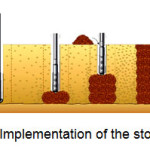 |
Figure1: Implementation of the stone column |
In table 1. The most significant studies in recent years, including assumptions and techniques of study in this regard have been collected in brief.
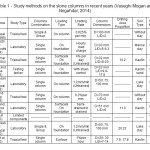 |
Table1: Study methods on the stone columns in recent years (Vaseghi Mogan and Negahdar, 2014) Click here to View table |
The granular material in the form of the layer to be dumped in wells drilled by the special vibrating devices whereas their density increases. The stone columns in fine soil (silt and clay), loose sandy soils are used. Stone columns design load is typically around 20 to 50 loads. The purpose of the column stone as an option to improve soil is the following:
- Increase the bearing capacity and reduce settlement of vast areas that are under load.
- The bearing capacity of the stone columns is good.
- The stone is a method of the economic improvement
- Using stone columns in the silt and clay soils with good compressibility and shear strength of the ground's surface is typically around 15 to 50 KN/ m2 increases (Mylonakis et al., 2000) .If shear force , in Figure 2, such as the earthquake shear force effects in the soil, angular shear strain γ is produced. If we use the stone column, it is assumed that the angular strain of the soil and stone column are equal (stone columns hardness is 2 to 5 times of the surrounding soil). In this case, using the balance of forces we can write

Given the amounts of soil and stone γ are equal, thus

In which Ac & As respectively represent the horizontal area of the soil and the stone column, as well as Gc & Gs are the soil shear modulus and the shear modulus of the stone columns (Abdullahi et al., 2006).
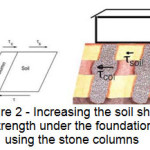 |
Figure2: Increasing the soil shear strength under the foundation using the stone columns |
The introduction of The Soil Layer
The most important part in the selection of soil layer is its dynamic period, which is corresponds to the frequency of the site first mode in the free field analysis after to be nonlinear of the soil; therefore, according to the 2800 code of Iran, the soil type is the clay soil located on the rocky bed which symbolically shown in Figure 3. In cases where the dynamic period of the soil layer is away from the structure period based on itself, the interaction of structures other than the main structure generally illustrates decreasing effect on the nonlinear response (FHWA/RD, 1983).
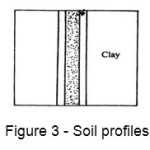 |
Figure3: Soil profiles |
Equations of Motion
A common method for dynamic analysis of a structure is that the ground’s free motion at the site specified and then applying the structure - foundation motion is considered as a rigid (E.Bowles et al., 1997).
If the structure is built on soft or soil reinforced, in this case during an earthquake, nonlinear behavior of the underlying soil and the interaction phenomenon occurrence of the soil- structure accordingly that it could be concerned quite different from the response of a structure with the rigid foundation and is affected by the movement of the ground free field. In other words, if the soil bearing capacity of the soil bed under foundation, with the implementation of stone column group to be modified 100%, it is like dealing with the soil type I to type III (2800 code). Otherwise, the nonlinear behavior of the soil is also effective and will be considered in the calculation.
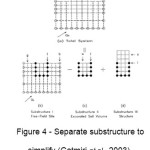 |
Figure4: Separate substructure to simplify (Gatmiri et al., 2003). |
Surveys directed by researchers based on observations carried out at the different sites indicate the site soil nonlinear behavior structure and soil- structure interaction phenomena which can be conducted to increase the structural response despite the increase in damping and also cause the increase seismic forces exerted on the construction. Among the available several ways to solve the problems of the soil- structure interaction, it can be pointed to some technics such as an engineering simple solution, the direct method, the mixed method and the infrastructure method.
In earlier method, soil- structure interaction problems have been divided in the set of the easier issues, then the results are combined together using the principle of the total force effects.
In the method of infrastructure breakdown is assumed that the soil- structure interaction is occurred just in the common boundary of infrastructure, the contact area of the foundation with the soil or stone columns group with the soil.
Due to the stone columns, the surfaces are changed depending on the number and layout of the columns. The breakdown is shown in Figure 4 (Gatmiri et al., 2003).
The equation of the infrastructure motion as shown in the Fig below can be written in the following matrix form

Stimuli applied to the harmonic, with frequency, load and displacement vector can be composed as follows

When {Q} and {u} mixed force and displacement vectors are in ω. Consequently, the equation of motion for each frequency shall be as follows

The equation of motion of the soil- structure interaction system, can be separated as follows

And indices I, II and III are related to the three infrastructures and the indices i , w and s, respectively are pertaining to the degrees of freedom and also are corresponding to the available nodes on the boundary of soil - structure, soil volume removed and the supernatant structures part (Etezad et al., 2005).
Free Field Response Problem
To solve the problem of site response, it is necessary to model and solve eigenvalue1 problem. Also in the calculation related to the waves, a volume of the sub-matrix calculated pertinent to the characteristics of each layer is used to form the eigenvalues equations.
Voss, as per the site model with horizontal layers and the assumption of the linear transformation, within each layer, is written the deformation the eigenvalue problem for the system in the frequency domain. Eigenvalue problem can be divided into two distinct algebraic eigenvalue problem, one for the Rayleigh wave motion and another one for the Love wave motion.
Using the soil decomposes, eigenvalue equation for Rayleigh wave motion can be written in the following matrix form

The method of the infrastructure breakdown, equations of motion for SSI, including impedance matrix (Xff) as shown in equation 8(.In this method, the impedance matrix is calculated only for the boundary nodes.
i nodes in the form of every frequency analysis of the impedance matrix by inverting gently dynamic matrix calculated. In three-dimensional problems, the issue of smooth dynamical matrix estimation problem of finding the answers to the load horizontally layered system in the boundary layer is decreased.
B. Solving Impedance
The structural characteristics and the soil removed, which includes elements of the matrix Css, Csi & Cii, the coefficients in the matrix are utilized and calculated using the equation of motion.
Structural Analysis
Structure and soil removed by standard finite element models and then dynamic characteristics are calculated (Hughes et al., 1974).
Equation of Motion
In the case of stable stimulation of dynamic soil- structure system, equation (8) at selected discrete frequency harmonic forms and dissolves. In the case of harmonic excitation results, accelerating the conversion functions that represent a complex harmonic response of the system to input harmonic motion at a control point (Balaam et al., 1977).
Respectively, Transient movements like earthquakes, are analyzed using the discrete Fourier transform. Using these techniques, the basic input motion specified in the N distinct points, the period T is uniformly distributed the final result is obtained after adding the following

The Dynamic Soil-Structure Interaction Analysis and Results
Dynamic soil- structure interaction analysis by considering the nonlinear effective behavior of the soil, for different combinations of structure, site and seismic environments done.
A. The Relative Stiffness of Soil-Structure Effects on Structural Response
Structural changes in the magnitudes of response can be attributed to the relative hardness of the soil to the structure, by quantifying the parameters 1/σ = h/(Vs.T) are to be measured, when h, Vs and T are defined as follows (Maleki et al., 2010).
In response to the higher magnification of the structural response equal to 6/5 in 1/Ï, equal to 0.5 happens to be related to the type of bracing of structure located on site type IV, of incoming momentum level is about 0.25 in the acceleration of gravity against the lowest magnification structural respond 1.05 in (1/Ï) to about 0.1 occurs that is related to the of structure strength of the frame on site the type II, the acceleration of gravity is brought about 0.05. High levels of zoom range are pertinent to the bracing type of site the type IV.
The Effect of Vibration Intensity Earthquake onthe Structural Response
Due to the damping effects and nonlinear behavior, depending on the shear strain of the underlying soil structure, acceleration input level can have a significant effect on the response of the structural response (Etezad et al., 2005). The hardness of the site is reduced by increasing the input acceleration. Reduce the hardness of the site, as well as the frequency content of the input motion, it generally affects the structural response (Etezad et al., 2005).
B- 1. In terms of the flexibility under foundation for stone columns group and consideration of soil alone makes damping compared to the soil- structure system.
B- 2. In comparison Tabas, Naghan and El Centro earthquakes response spectrum, and El Centro, Naghan for structures including soil- structure interaction with the rigid column can state
B- 2.1. within the period of 0.4
B- 2.2. in the period 0.5 et al., 2014).
B- 2.3 in the range 1
B- 3. in comparison with post-earthquake response spectrum, Naghan and Alsenter including SSI, reflecting spectrum the range of soil types II, III and IV respectively in the 2800 code periods of less than 0.2, 0.3 and 0.5 Sec. is seen, there are significant differences; however, in periods greater than 0.5 seconds, the reflection spectrum, the regulations on good coverage including SSI response spectrum (Samadian et al., 2004).
B- 4. Concerning the soil- structure. The type of the soil is very important interaction problem and the shear wave velocity in the soil is less, the effect of soil- structure interaction analysis will be more.so that the Figure 5 confirms the above issue.
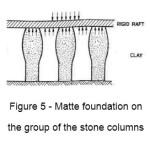 |
Figure5: Matte foundation on the group of the stone columns |
Recent studies on groups of stone columns were installed in the soft soil article suggests that due to the interaction of the column shear overall failure may be in the form of a cone and failure, as shown in Figure 6 (Saidirizi et al., 2013).
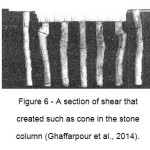 |
Figure6: A section of shear that created such as cone in the stone column (Ghaffarpour et al., 2014). |
Referable to the effects of soil- structure interaction on response spectra, it is advocated that as ATC criteria, some relations are added for considering the essence of the interaction of soil- structure (based on the dynamic properties of soil- structure is modified) to the Code of 2800 or by considering soil- structure interaction spectrum, including design response spectra to be corrected. Figure 7 symbolically represents the structures were carried out on groups of stone columns.
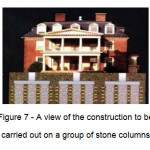 |
Figure7: A view of the construction to be carried out on a group of stone columns |
Conclusion:
The results obtained of the analysis for various parameters of the stone columns such as the number of the columns, the foundation width, the distance between the columns, elasticity modulus ratio of the stone column material to the elasticity modulus of the soil, Poisson's ratio of rock and soil materials and eventually, the column length on the behavior of reinforced with stone columns represents the effect of amplitude changes That the range of amplitude changes in different conditions of soil and stone columns has different effects (Tabrsaz et al., 2010).
- Decreasing of the sandy soils density in the field of the construction of stone columns groups and due to differences in both static and dynamic settlement of the supports, the soil- structure interaction effects will be increased.
- The main mechanisms of the soil- structure interaction leading to the horizontal and rocking motions of the foundations are concerned. If the shear force and bending moment caused by the difference between stone columns settlement (backrests) on the effect of soil- structure interaction in a bottom-up of structure is declining.
- The results indicate that neighboring structures had little effect on the attenuation and frequency, as in the case of soft soil type (IV) form the functional behavior of adjacent of structure can be observed.
- The increase in friction angle in granular materials in stone columns, resulting in increased strength and reduce slightly the settlement in the stone columns. The results also suggest that the greatest amount of stress occurs at intermediate depths. It is worth mentioning that the effects of optimum length of the stone columns in thematic layers that can be studied in the future, and further research are either analytical or numerical methods.
Economically, new experiences indicate that if there is a suitable bearing layer at a depth of 6 to 10 meters, implementing of the stone columns is economic. However, normally implementation of stone columns with a length over 10 meter is not economic and their fulfillment are difficult as well, although in U.S.A. and Europe has been implemented the 21 meter stone columns. Typically, the stone columns are used in the soils which their undrained shear strength is less than 7 kN/ m2. Otherwise, the important thing is that in the sensitive soil which contains the organic matter due to the high compressibility and the stone column is possible to encounter with the adverse expansion concerning the lateral support of the soil.
References
- Abdullahi, R., Nazari Afshar, And Vosoughifar, H. R., "Application of the method of applying the foundation stone columns to stabilize the surface on loose ground," the first international conference on seismic retrofitting (2006).
- Balaam, N. P., Brown, P. T. and Poulos, H. G., “Settlement Analysis of Soft Clays Reinforced with Granular Piles", proceedings of 5th international conference on soil engineering, Bangkok, Thailand. 81-92,(1977).
- E.Bowles, J. P.E., S.E., “Foundation Analysis and Design”, 5th Edition, (the McGraw-Hill Book Co- Singapore. 1997).
- Etezad, M., Hanna, A. M. and Ayadat, T., “Numerical model for group of stone columns”, Proc. 73rd Annual Meeting of ICOLD., Tehran., Iran., paper No. 097-OT (2005).
- FHWA/RD. “Design and construction of stone column”. 1(12), 268-293(1983).
- Gatmiri, B., Haeri, S. M. And Et al., "Guide to the analysis of dynamic soil-structure interaction and its effects on the dynamic response of structures" Natural Disaster Research Center of Iran's Islamic Revolution Housing Foundation (1978).
- Gatmiri, B., And Tajoddini, h. F., "Effects of long nonlinear behavior of soil on the dynamic response of structures", College of Engineering, 37(2), 283-294(2003).
- Ghaffarpour Jahromi, S., Gorbanbegi, S. And Yaqub, M., "Evaluation of Fracture Mechanics of land improved with stone columns", First National Conference on Soil Mechanics and Foundation Engineering, University of Tehran Rajai martyr teacher training (2014).
- Greenwood, D. A., “Mechanical improvement of soils below ground surface”. Ground Engineering Proceedings Conference Organized by the Institution of Civil Engineering, London, June,11-22(1970).
- Hughes, J. M. O. and Withers, N. J., "Reinforcing of Soft Cohesive Soils with Stone Columns", Ground Engineering, 1(3), 42-49(1974).
- Maleki, M. And Saifalizadeh, A. D., "Dynamic Analysis of soil-structure interaction using two contrasting Software Sap and Flac", Fifth National Congress on Civil Engineering, Ferdowsi University of Mashhad (2010).
- Mortezai, A. R., Shahrokhifard, H. And Taheri, P., "Principles of dynamic soil-structure interaction ", First Edition, Tehran, (Sanei publications 2014)
- Mylonakis, G. and Gazetas, G., “Seismic soil-structure interaction: beneficial or detrimental.” J. of Earthquake Engineering, 4(3), 277-301(2000).
- Naeim, F., “The Seismic Design Handbook”, 2nd Edition, (John A. Martin & Associates, INC., 2001)
- Saidirizi, A., Marandi, M. And Fooladi, A., "The impact of the stone column bearing capacity of the soil", the first National Conference of Geotechnical Engineering, School of Engineering, Mohagege Ardabili University, Ardebil, (2013).
- Samadian, B., Janalizadeh Chobbasti, A. And Vaseghi Amiri, J. (2004), "considering soil-structure interaction in the dynamic analysis of structures", First National Congress on Civil Engineering, Sharif University of Tehran, (2004).
- Tabrsaz, S. And Sorush. A., "Numerical analysis of the behavior of reinforced with stone columns", Civil Modares Journal, 1(2), (2010).
- Vaseghi Mogan, S. Negahdar, H., "Experimental and Analytical Study of stone columns with wrapping", First National Conference on Soil Mechanics and Foundation Engineering, University of teacher training on shahid Rajai, Teharn, (2014).







